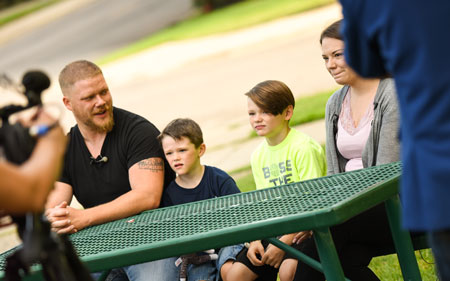For a parent of a young child, potential danger can take many forms. Most are common threats we all understand and deal with ourselves daily, such as busy intersections, buzzing hornet nests, or icy sidewalks.
But what about within the confines of our homes? We all have that under control, right?
Parents have long safeguarded their homes by doing things like covering electrical outlets or utilizing baby gates to keep staircases closed. We’re all familiar with child-resistant packaging and pill bottles that keep our children safe. But what other household risks should you consider?
The North Memorial Health Trauma Team says we should take a closer look not out our windows while contemplating, but at our windows while realizing they can pose a real danger if not properly guarded against. “Every spring and fall when people open their windows and let the fresh air inside, it creates a danger for little kids,” says Dr. Jonathan Gipson, trauma director, North Memorial Health. “Across the country we see about 3,300 times a year where kids fall out of windows.”
That’s about nine kids a day. Of those, an average of eight die from their injuries every year.
The Anderson’s story
On a spring day in 2016, Jake and Jenny Anderson learned just how dangerous an open window could be when their three-year-old son Michael leaned on and fell out of a screened window on the second floor of the family’s home while playing on a nearby couch.
“I was cooking dinner and the boys were upstairs in the living room,” said Jenny. “I could hear them yelling outside, but I didn’t think much of it. I told him to get down from the couch and then the next thing I heard him crying outside.”
“I look upstairs and the screen is gone in our window,” said Jake, Michael’s father. “I felt sick to my stomach and ran outside and there he is.”
The Andersons scooped Michael up and raced to Maple Grove Hospital where it was determined Michael would have to be transferred to the pediatric trauma unit at Robbinsdale Hospital. He had fractured his skull and needed surgery.
“As soon as we got there they took excellent care of us. That was the scariest day of my life,” said Jake.
Two years later, Michael has fully recovered from his injuries and even got to reunite with Dr. Gipson and the trauma team who helped save him.
“I did not know what to expect that day,” said Jenny during the reunion. “It’s just so great that [the trauma team] did an amazing job and were able to bring him back like this.”
Dr. Gipson and our trauma team say that screens alone shouldn’t be viewed as a safety mechanism for an open window and urge parents to be mindful of where they place furniture in rooms to avoid accidents such as Michael’s. Windows that seem out of reach can become dangerous if your child is able to climb furniture or other objects nearby.
Extra safeguarding can come in the form of what landscaping you install outside of your home. Things like shrubs or bushes make a softer landing than rocks or gravel should a fall occur. Most importantly, just changing your perspective about the risks in your home can help prevent accidents.
“I never thought I had to take extra precautions inside the house,” said Jenny. “It was definitely a learning experience. I now realize everything around the house could be a danger and I try to protect him from everything. The windows were definitely not on my radar at that time.”
Falls aren’t the only risk windows pose
Window cords for blinds or drapes can cause strangulation if left in reach of a child. According to the Consumer Product Safety Commission, nearly 12 children a year die from window-covering cord strangulation. These incidents are particularly dangerous because they happen silently.
To prevent window covering cord strangulation:
- Use window coverings without cords. Many cordless options are available.
- If you do have cords, make sure you regularly check that all cords are out of reach. Tying them up at the top of a window can keep them secure and away from a child’s grasp.
- Keep all cribs, beds or furniture away from windows.
Window safety tips
(Via National Safety Council)
- Always supervise children and keep their play area away from windows.
- Keep windows closed and locked when children are present.
- If windows are open, make sure children can’t reach them.
- For a double-hung window on an upper floor, open the top sash for ventilation and keep the bottom sash closed.
- Screens keep bugs out, but they do not keep children in.
- Keep furniture away from windows as they could tempt a curious child to climb and potentially fall.
- Don’t allow children to jump on beds or other furniture.
- If there are young children in the home, install ASTM-approved limited-opening hardware, which only allows a window to open a few inches.



